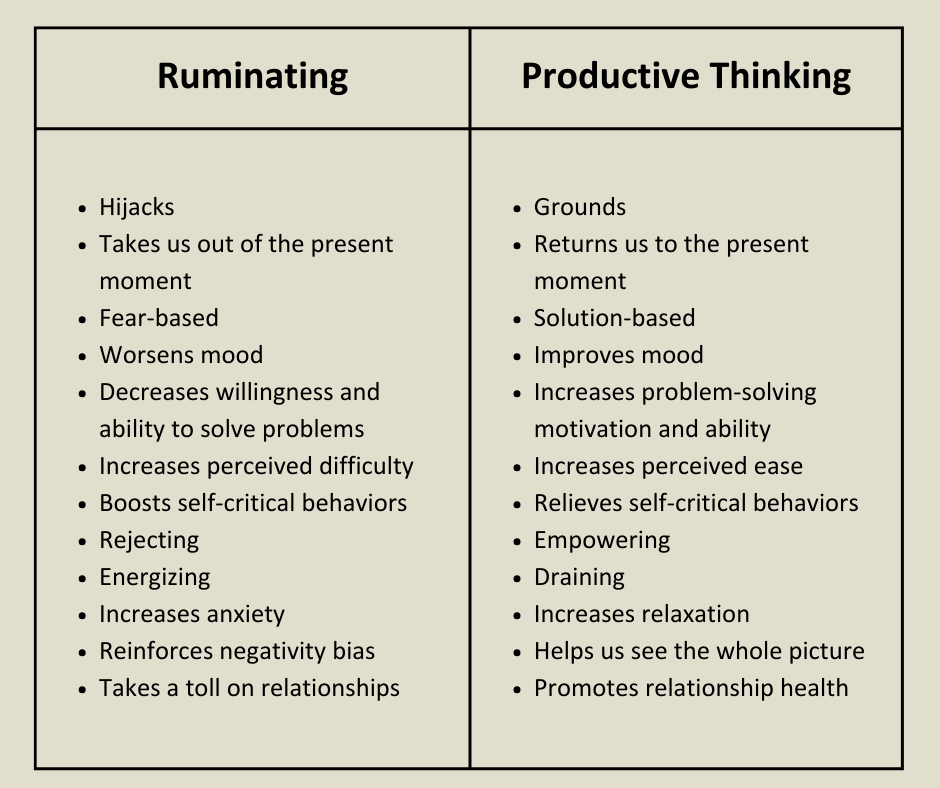Let that Sh*t Go: Don’t Ruin Today by Overthinking About Yesterday
How ruminating opens the door to depression—and 3 steps to help you compassionately close it.
Damn, I’m hungry.
Those berries look juicy and delicious.
But hold on. Ralph ate similar berries last week, and he got super sick.
I don’t want to get sick, too. So, I’ll keep foraging for something else to eat.
A Fear-First Approach to Survival
Our brains are programmed to remember the bad stuff. This fear-based software is adaptive and helps us survive.
However, our negativity bias shortens pleasant emotions. After all, the good stuff isn’t helpful for survival.
This negative tendency also predisposes us to focus excessively on a problem and its potential solutions, known as ruminating, or “going over in the mind repeatedly, and often casually or slowly.”
For those of us prone to overthinking and depression, ruminating is a first step toward a feedback loop that eventually:
1. becomes uncontrollable
2. causes our mental safety nets to fall by the wayside, and
3. allows us to descend into a crisis quickly.
I recently learned about rumination through a beautifully illuminating intensive outpatient program (IOP). And combined with dialectical behavioral therapy (DBT), it’s completely changed how I recognize and interact with the different phases of my mental wellness, from baseline to crisis.
Most of all, it’s a powerful tool that allows me to catch myself during an initial descent and compassionately pull myself back to baseline.
My hope is that it works equally as well for you.
What Fuels Rumination’s Fire?
I love spending time outdoors.
But the likelihood that I’ll forage for berries in the forest anytime soon? Pretty low.
And if I wanted some berries, I could open the fridge and remove the carton I picked up from the grocery store this morning.
Still, my brain is hard-wired to dwell on negativity.
Therefore, with the threat of poisonous food (and most external perils in modern life) mitigated, my mind turns its focus toward internal “threats:”
Remember what you said to your then-girlfriend during that argument 30 years ago?
Can you believe you’re middle-aged? You haven’t accomplished much, have you?
Who didn’t reach out to you this year on your birthday? Why not? Are you unimportant?
Look at all these mistakes in your life: are you doomed to fail?
What do your girls think about your challenges? How crazy do they think you are?
The fuel for rumination’s fire is endless since my life is stacked with coulda-woulda-shoulda moments drenched in embarrassment, shame, guilt, and regret that I could replay indefinitely if left to my own devices.
Rumination May Keep Us Safe. But It Can Also Trigger Depression.
Here’s the thing, though: I don’t just cling to these negative memories. My brain also infers that because things went wrong in the past, they’ll continue going wrong in the future.
And my body responds accordingly.
Not able to differentiate between now and what may occur (however unlikely) at some point down the road, and to prepare for this inevitability, it triggers a physical stress response, including symptoms like:
Fatigue
Headaches
Irritability
Nausea
Nervousness
Difficulty concentrating
Changes in eating and/or sleeping habits
Sweating, trembling, or rapid breathing
Worry and related stress are also known triggers for depression.1-6
Rumination is an evolutionary adaptation that provides an advantage. The more we worry, the less likely we are to eat poisonous berries or harm ourselves in some other way.
The problem? Happiness isn’t an evolutionary advantage.
So, while worrying about harm may keep us safe, it won’t make us happy.
Therefore, the question begs: at what point does healthy negativity bias turn into unhealthy rumination?
Identifying the Difference Between Ruminating & Productive Thinking
Depression is a liar.
As one of its gatekeepers, rumination fabricates a false reality. It makes us think we’re working toward something fruitful when we’re only spinning in circles.
Rumination also provides false comfort. If we’re dealing with psychological pain, working within the confines of its feedback loop allows us to disengage from the present moment. Then, it becomes a form of avoidance; an internal distraction.
Comparatively, productive thinking anchors us in the present moment. It’s also time-limited (we only think about it for so long before moving on), whereas rumination is unbounded and can steal days—or weeks, months, or years—of our lives.
Other differences between ruminating and productive thinking include:
How, then, can we stop ruminating?
Let’s start by releasing any hopes that we can get rid of it. Remember: we’re hard-wired to worry. It’s not going anywhere.
Instead, we need to:
Recognize when we’re ruminating.
Consciously tell ourselves, “Nope! I’m not going down this spiral. I won’t be swept up in these lies.”
Redirect toward something productive.
Move forward with our newfound awesomeness.
Like a train, rumination is much easier to stop before it’s traveling full-steam ahead.
However, similar to stopping a train—even a slow one—in the real world, identifying and ceasing our rumination takes effort.
Rumination Cues Action: 3 Steps for Reclaiming Your Power from Depressive Spirals
It also takes practice.
Fortunately, the rumination cues action (RCA) technique is straightforward. But if you’re like me, your mind is a skillful ruminator, so it will likely take some trial-and-error before it’s an effective tool.
With this in mind, RCA essentially helps you train yourself to identify rumination and then replace it with a productive action. It can be loosely broken down into three steps:
Step 1: Name It to Tame It Using the 2-Minute Rule
We often ruminate unconsciously.
So, the first step toward regaining our agency is to make the unconscious conscious. We must first see it, and then we can label and externalize it.
Identify your related thoughts, feelings, sensations, and any other red flags (e.g., replaying the same thing over and over, being especially hard on yourself, worrying about the future, etc.).
As you begin to notice familiar thought patterns, allow yourself to think about them, but set a time limit of two minutes. Afterward, ask yourself three questions:
Have I made any progress toward solving a problem?
Do I understand something about the problem (or my feelings about it) that I didn’t understand before?
Do I feel less self-critical, depressed, or anxious than before I started thinking about this?
Unless you respond with “yes” to any of these, you’re ruminating.
Armed with this knowledge, you can then say, “This is what rumination looks like for me. I know I’m ruminating if…”
Step 2: Make a Decision
It won’t be easy. Rumination is familiar and addictive.
But after identifying it, you must actively choose to avoid getting lost in its spiral.
You can’t just not ruminate, though, right? I mean, if someone tells you not to think about a banana, what’s the first thing likely to pop into your head?
Instead of waging internal warfare, you have to divert your attention.
Step 3: Force Your Brain to Focus on Something Else
Almost anything you can do to return your attention to the here and now can be a healthy tool. Engage the senses in one way or another:
Drink a hot cup of tea or coffee
Enjoy a long shower
Light candles
Watch a favorite movie
Read a book
Journal
Organize an area of your home
Take a walk
Cook a meal
Feel the sun on your skin
Call a friend
Meditate
Keep in mind that the activity doesn’t matter.
What matters is that you’re practicing the skill of mindfully redirecting your attention away from rumination and toward something productive, over and over.
Step 3a: The Push-Away Technique
Once I’ve identified a rumination spiral, one tool I’ve found especially effective is the “push away” technique, which involves asking myself two questions:
Is there something I can do about it?
Is this a good time to work on this problem?
If the answer to both questions is “yes,” then I can get to work doing something about it, which moves me from the past into the present.
However, if the answer to either question is “no,” then I can choose a distraction method in step three.
Either way, I’m stopping my rumination descent in its tracks, which is one more way I’m able to maintain my mental wellness.
I’d love to know: Do you experience a link between rumination and depressive spirals?
Have you tried the RCA technique? If so, was it effective?
If not, do you use any other techniques for taking back your power from depression?
References




